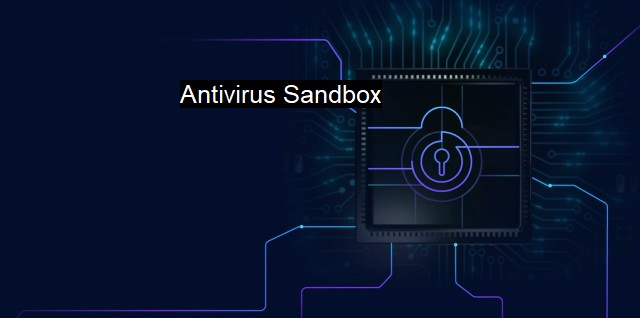What is Antivirus Sandbox?
Exploring the Essential Defense of Antivirus Sandbox in the Age of Malware and Cyber-Attacks.
In the realm of cybersecurity and antivirus protection, the "antivirus sandbox" is a prevalent term. Understanding what it is, how it operates, and why it is beneficial will provide a broader picture of the degree to which technology safeguards our computer systems and digital environment.The pseudo-environment referred to as an "antivirus sandbox," sometimes just called a "sandbox," is a security mechanism for separating running programs, often employed to execute new, unfamiliar, or untested software code or programs while minimizing system exposure to software vulnerabilities. Therefore, an antivirus sandbox can be thought of as an isolated, controlled setting wherein behavior can be safely examined and evaluated. It serves as a virtual "playground" that deliberately hinders the potential spread of any malicious or harmful content across the broader system.
Now let's delve into deeper comprehension. Imagine receiving a file attachment in an email from an unknown source or travelling across a suspicious-looking website. Your antivirus software may identify the code as potentially malicious because it hasn't previously encountered something quite like that. it isn't sure if it's indeed malicious. An antivirus sandbox will take that code, apply it in an isolated environment, and monitor what it does. If the code tends to behave maliciously, such as by targeting or accessing system files or triggering irregular system behaviors, the sandbox environment would be able to probe that activity without endangering the complete system.
Thus, the essence of an antivirus sandbox rests on this very ability – experimentation without introduction of risk to the system. In reality, some programs and pieces of software need to act on system files to operate correctly — an antivirus sandbox is a tool that helps distinguish between safe and potentially harmful actions.
Over recent years, sandboxes have become increasingly utilized as components of comprehensive, multi-layered security strategies, namely due to their dynamic nature as opposed to more traditional, signature-based antivirus measures. As new threats rapidly evolve, surpassing default signatures, sandboxing provides a viable means of examining and evaluating these relatively unknown forms to keep pace with ever-evolving cybersecurity demands. Besides, it not just identifies potential risks involved but also aids in extracting vital threat intelligence data. It can provide detailed insights into the behavior of malicious software, endpoints affected, and backtrack an incoming threat to its origin.
No tool is flawless and nor is an antivirus sandbox. Some sophisticated malware types can recognize that they're in a sandbox environment and would abstain from executing malicious actions until they're out of the sandbox. deploying and managing sandboxes also require considerable resources and expertise, particularly for larger organizations operating on large scales.
Antivirus sandboxes play a key role in modern cybersecurity defenses by offering a cramped simulated environment to learn about and respond to potential threats more efficiently. By permitting the execution of suspicious code in a sandbox, instead of spurring instant alarms or blocking the file, more comprehensive security outcomes can be achieved. In particular, antivirus sandboxes are indispensable for perpetually inspecting new threats running rampant in today's fast-paced digital age, despite small criticisms they receive. Providing these fortresses of insulation, sandboxing techniques embody a major breakthrough towards comprehensive systems and online security that meet contemporary cybersecurity demands.

Antivirus Sandbox FAQs
What is an antivirus sandbox?
An antivirus sandbox is a virtual environment that allows the testing of suspicious files and programs in a controlled and isolated environment. It is used by antivirus software to analyze and determine the behavior of potentially harmful programs and files without risking the security of the entire system.What are the benefits of using an antivirus sandbox?
Using an antivirus sandbox has several benefits including: it provides a safe environment to investigate suspicious files or programs, it reduces the risk of malware infections, it increases the accuracy of malware detection, and it prevents sensitive data from being compromised during the malware analysis process.How does an antivirus sandbox work?
An antivirus sandbox works by isolating suspicious files or programs from the rest of the system and analyzing them in a controlled environment. The sandbox creates a virtual machine that simulates the operating system and allows the suspicious file or program to run, while also monitoring its behavior. The sandbox then analyzes the behavior of the file or program to determine whether it is malicious or not.What are the limitations of an antivirus sandbox?
Although an antivirus sandbox is highly effective in detecting and analyzing malware, it has a few limitations. Some malware is designed to detect and evade sandboxes, making it difficult for antivirus software to detect it. Additionally, a sophisticated attacker can design malware that can bypass a sandbox, making it difficult to detect and analyze their malicious activities. Finally, the sandboxing process can be time-consuming, which can affect the speed and performance of the system.| | A | | | B | | | C | | | D | | | E | | | F | | | G | | | H | | | I | | | J | | | K | | | L | | | M | |
| | N | | | O | | | P | | | Q | | | R | | | S | | | T | | | U | | | V | | | W | | | X | | | Y | | | Z | |
| | 1 | | | 2 | | | 3 | | | 4 | | | 7 | | | 8 | | |||||||